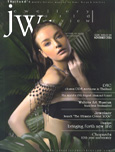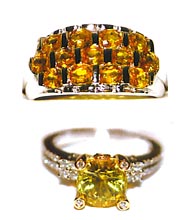| |
November
: Yellow Sapphire Courage and Wisdom |
|
| |
You
can have a "Royal" and "Golden stone" if your birthday
falls in the month of November. The stone is a Yellow Sapphire, also referred
to Golden Sapphire.
Yellow
Sapphire, the birthstone for the month of November denotes courage, wisdom
and sincerity. Those who wear yellow sapphire will have a good life and
be blessed with good health and prosperity.
|
|
| |
It
is also the most preferred stone in the Breastplate of the High
Priest of the Jews. As it is an extremely powerful gem, the ancient
Egyptians called the stone "RA", the sun god or giver
of life and fertility.
Yellow
sapphire increases manliness. This gem is considered to be the symbol
of sincerity. By wearing yellow hire, the husband and wife will
remain faithful to each other throughout their life and be very
happy.
Yellow
sapphire is also known to improve interactions, act as an energizer
and result in clearer communications.
|
|
|
According
to ancient lore, yellow sapphire possesses great healing Powers.
It is believed that yellow sapphire can help overcome kidney and
bladder disorders, cold and tuberculosis. |
|
|
|
|
| |
Citrine
Citrine
is a yellow quartz which is a substitute for yellow sapphire. It is said
to possess almost the same powers. Both are the color gems of the sun.
They bring light and warmth to the wearer. lf you can not afford a yellow
sapphire, wear a Citrine instead.
|
|
| |
|
|
| |
|
|
| |
Walters
Art Museum launches Bedazzled: 5,000 years of jewelry |
|
| |
Featuring
nearly 150 pieces of jewelry largely : from the Walters Art Museum's collection
in Baltimore, US, "Bedazzled: 5,000 Years of Jewelry" will travel
to three US venues from September 2006 to August 2007. The selection from
the Walters' collection presents the evolution of techniques and materials
from 3,000 B.C. through the early 20th century and provides examples of
the museum's jewelry holdings.
|
|
| |
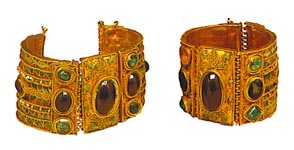 |
|
The
selection was assembled primarily by one of the Walters Art Museum's
founders, Henry Walters (1848-1931), during the first three decades
of the last century. It presents the evolution of techniques and
materials throughout the ages, and also demonstrates the importance
of jewelry as an expression of creativity and often of wealth and
position. Works from the ancient world and Egyptian treasures will
also be featured. |
| Bracelet from Olbia, Hellenistic, Greek,
late second century BC |
From
Olbia, the site of a Greek colony on the Crimean peninsula in the
first century B.C., comes a bracelet decorated with gold granulation
and set with gemstones backed with foil. Examples from the Renaissance
period include pendants incorporating enameled figural elements,
mounted with pearls and gemstones, and detailed gold dress ornaments
illustrating the height of 16th-century fashion. |
|
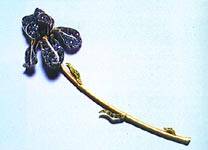 |
| Tiffany & Co., American, Iris Corsage
ornament, gold, sapphires, demantoid garnets, topaz & diamonds,
purchased by Henry Walters, 1900 |
|
|
| |
A
special focus in the exhibition will be on finger rings throughout history.
The role of the rings as emblematic of love, marriage and death will be
illustrated with medieval posy rings, and Renaissance marriage rings.
Special emphasis will be placed on diamond-set rings as symbols of status,
and the technological development of diamond cutting. |
|
| |
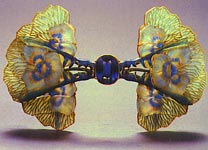 |
|
Gems
from the early 20th century include a Tiffany corsage in the form
of an iris set with 139 Montana sapphires, and several art jewels
that were displayed by Art Nouveau jeweler Rene Lalique. The exhibition
will visit the Frist Center for the Visual Arts, Nashville, Tennessee
and the John and Mable Ringling Museum of Art, Sarasota, Florida.
A third venue will follow. |
| Rene Lalique, French, Pansy brooch, 1902/4,
Gold, Glass, plique-a-jour enamel, sapphire, purchased by Henry Walters,
1904 |
|
|
| |
|
|
| |
|
|
| |
|
|

